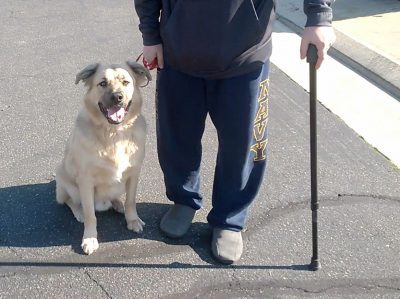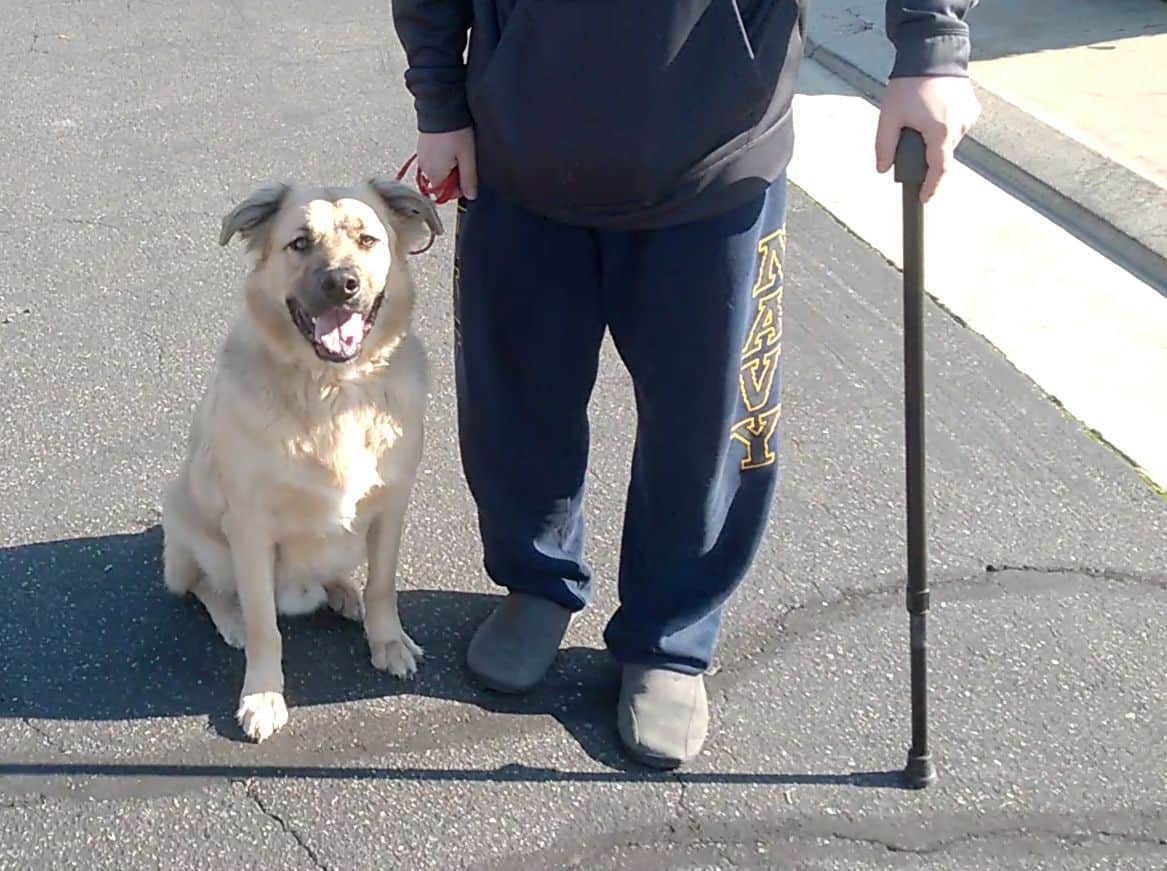Bear Learns to Stop Sit and Wait
Here’s the audio taken from video at one of my past Fast In-Home Dog Trainings. There is my voice doing the training, Joe Ozier, along with the several occupants of the home that I have been called to. They are Fabian, (the disabled dog owner), and his Brothers. The dog is named Bear. He has had Petco type training as per his owner.
Bear’s issues: He Becomes Aggressive Towards Guests
Bear becomes aggressive to anyone around him at the sound of the Doorbell (including his disabled dog owner). He becomes aggressive to people entering the home (family or not). My clients dog also becomes aggressive to people passing by the front of the home. Bear also always pulls his disabled dog owner off of his crutch so he no longer takes his dog on walks.
His owner is on disability from an armed forces accident and favors one side over the other. Bear is so strong that he pulls his owner off balance and exploits his weak leg and grip to get away.
Bear Learns His Disabled Dog Owner Makes the Decisions
He also needs to learn how to appreciate the praise or “treat” given to him as his reward for good listening. I’m going to test to see how obedient to listening or how nervous or trusting or how untrusting Bear is towards me.
It’s all about getting Bear to Stop Sit and Wait and to stop ignoring me (and his disabled dog owner). Teaching Bear to keep getting and earning his owners best side, his more easy side, is going to be in both his owner and Bear’s best interest.
The Following Is the Transcript for the First Hour of Bear’s Training
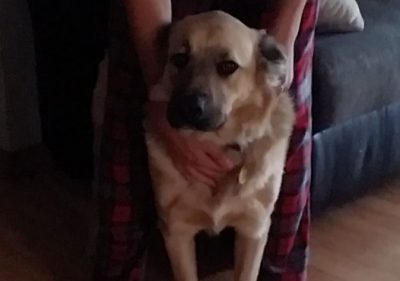
Joe: So that’s Bear and this one’s-
Speaker 2: Nacho.
Joe: … Nacho. Like Nacho Libre?
Speaker 2: Yeah.
Favian: Yeah.
Joe: Okay, awesome.
Speaker 2: Bear.
Joe: Yeah, Bear. Oh, this is a good one right here. Yes, this is what a normal dog should be like right here. This is normal doggy. Yes, hello.
Speaker 2: Bear.
Joe: Nacho. Come on.
Speaker 2: Bear, get a … Hey. And you just pet him like … He won’t bite.
Joe: Hello.
Favian: Yeah, well, how’s it going?
Joe: Hey, good.
Favian: Fabian.
Joe: Hey, Fabian. Joe
Favian: As you can see, that’s why we called you.
Joe: Yeah. Bear’s a little scary.
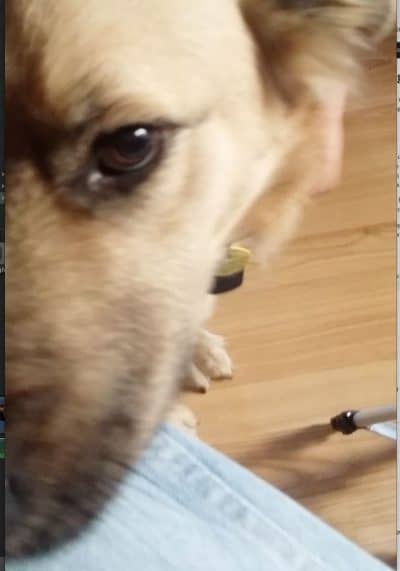
Speaker 2: Like I said, he doesn’t bite and he’s never bitten anybody.
Favian: No, like the closest he’s gotten to anybody, it looks like he’s trying to nip them. Like he pulled somebody’s clothes a little.
Joe: Mm-hmm (affirmative). Yeah, I can see that a little bit. Bear! Does he sit? Does he do anything?
Favian: Yeah, he’s gone through the pet smart training. The puppy, beginner, and intermediate.
Joe: Okay.
Alright, hello. You’re a good boy.
Favian: Careful with [inaudible 00:01:29]
Speaker 2: Yeah.
Favian: [inaudible 00:01:33]
Joe: Alright. So has anybody ever walked him besides you guys? You want to sit? Sit. Sit. Good! Hold on, no. Now you’re going to see … cause I like the little waggy tail. When I said good dog, sit down. Sit. Good boy.
So what I’m going to do is I’m going to get to him. I can see that he’s a little slippery on this … hey, hey, Bear. Sit down. Good boy. Good.
Favian: We usually tell him to wait [inaudible 00:02:21]
Joe: Huh?
Favian: We usually tell him wait.
Joe: Okay, so wait. I use stop. And I use stop, it’s the first thing I teach a dog because it covers a lot of stuff. It covers stop chewing, biting, barking, whatever you’re doing, I want you to stop. Stop it. Just wait and see what happens next from me. Like that. And that’s actually really good, cause he’s just sitting there. He’s not getting up. It’s just kind of like he’s waiting for the next … No, there it is. So sit down. Sit.
Favian: And this is what we use …
Joe: Hey. There you go. So I’m going to get to him. This may take a little time. Every dog is different, depending on … Yeah, please. Have a seat. Every dog is different, but the point is … Hold on, hold on. Sit down. Hey, sit.
Favian: He knows the … the hand gesture we use for sit is this.
Joe: This to sit? Oh, okay. Let’s try this. Okay, sit. Oh, well. No, sit. Sit. Hey, sit. Good boy.
Now, when you get a dog to sit, the scenario that I teach … hey, hey, hey. Up. Sit up. Good. Is stop, and then sit, and then wait. The wait part is like the most important thing. Once they’re down, to just nix it, wait. He’s more curious than me, which is why he’s, I think, staying on point, is because he’s more curious about what I’m doing and when I’m gonna do it, why I’m … Good. Sit down. Sit. Hey, sit. Like this? Is this what you’re doing?
Favian: Yeah.
Joe: Good, stop. So now that he’s stopped, what I want him to do is just stay there. So that’s all I’m going to do is I want him to learn this. You’re gonna learn the stops, you’re going to learn the hand signals, cause this is going to be the overriding … No. So what I gotta do is get him right back to where he was … Good, sit down. Sit. Sit.
And everybody has different hand signals and different ways of doing stuff, and so I gotta kind of override some of them in order to get my message across. And the message is that I want him to start appreciating the reward, the treat, okay? I don’t give him treats, but I do give him these. These are the praises. And I call them … like you could call it sugar or a praise or whatever. But by doing what I’m doing now, it’s going to test what’s going on in his head.
It’s just going to be more like … I want to see how obedient he is to listening, how nervous he is by following me and watching me and untrusting, and so it basically calibrates. It helps me kind of calibrate what level of determination and will that he has to do and keep doing what it is that he’s doing.
He’s going to be getting his rewards along the way, but just having him … Good, good. And now walking behind him is always an interesting thing, because most dogs don’t like it. People don’t like it, “Hey, what are you doing back there?” So it shows me the level of their trust or untrust or nervous or “get the hell out of here, I’m going to bite you.”
They all have their way of showing me what’s going on in their head, but he’s actually doing pretty good now, and he’s actually just kind of sitting there. And that’s all I want. I don’t want him to lay down, cause when a dog lays down, then they tune out. They just find a way to, “Oh, I’ll just sleep this one through … class, until class is over.” Good. There you go.
So that’s all … Oh, oh, no. No.
Favian: Come on, Nacho. Come here boy.
Joe: Sit, sit. Hey, sit. Bear, sit down. Good. Good boy. Stop. Stop.
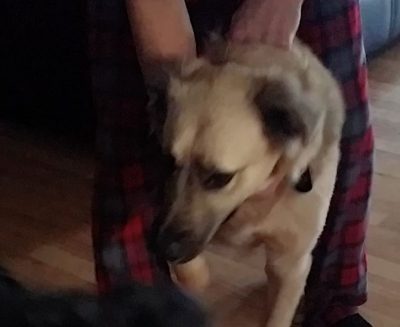
So he may want to be playing or doing other stuff, but dogs are really good at ignoring you. Great at ignoring. That’s their big thing, is to ignore you. Dogs want to do what dogs want to do when they want to do it. Right? They just think of something and go. That’s their MO. They don’t go, “Hmm, I wonder if I should chase that squirrel.” You know? They just boom! That’s it. They don’t even think about it.
So what we’re going to do is just test and see how he’s doing, and he’s actually doing pretty good. Good. Stop. Hey, sit. Sit. Sit. Hey, good! Stop. Stop.
Just moving him two feet and then four and then six and then moving him around, cause every home has different energies. Different energies in the doorway, cause people come and go and energy’s … there’s excitement and trees and neighbors and other dogs and all that stuff out there. Good. Thank you. Here. Well done.
This is when I start amping up the energy. Once I can walk around him without him going … you know being very untrusting. He’s actually doing pretty good. Some dogs take a lot longer. Now I’m going to start picking up the energy, and this is where we’re really going to see this. Right? You’ll know it cause dogs … Hey, sit down. Sit. Sit. Sit. Bear, sit. Good, just stop. Starting to get a little worried there. Did you see? He’s kind of like, “Oh, I’m done with this crap. I don’t like what you’re doing. I’m about ready to go back in my room and lay down,” or whatever.
And so that’s when we gotta calm it down. We gotta kind of come over the top of it. And dogs are very energy oriented. Over 10 million years of developing, they are very keen to see who’s a predator to them and who’s prey for them. So they’re like, “Are they going to kill me or can I kill them?” Or whatever, right? So they’re good at reading people and other energies and animals and stuff like that.
But so, when I start picking up the energy, then the dog’s kind of, “Hey, I gotta react somehow.” Up. Up. Up. Good. Sit. Sit. Sit. Sit. Sit. Good boy. Good. Stop.
So he’s going to learn through positive reinforcement instead of negative. “Don’t! If you don’t … whatever. Stop, sit, no, down, off, get,” all the negatives he probably knows pretty well.” But what we’re going to do is turn that all around and give him praise for doing what it is that we want. And it makes a lot of sense, right? Most people don’t really look at it that way.
They want to teach a dog all the no things, but they don’t want to go, “Yes! That’s what I want. I like this attitude. I like softer, more gentler … ” Hold on. Good. So every time … This is all part of it. You may not know this, but I’m going to try to tell you all the things so that you understand what it is that I’m doing and why I’m doing it.
So when he looks at me, he’s like doing this the whole thing. You’re me, right? He’s doing this. And every so often he’ll look up at me, and when he does, you (now me) are going to go, “Oh, thank you for looking!” Okay? Looking. Just connecting. Cause he just connected for a moment, and he’s still kind of looking, but he’s not really. He’s more concerned … Hold on. Bear! Oh, there you go.
How old’s bear?
Favian: He’s going to turn two.
Joe: Oh, he’s a baby.
Favian: Yeah.
Joe: He’s just a baby. He’s just a baby. Good boy. Stop. Sit. Not bad. Not bad. This one reacted, but Bear really didn’t. He just was checking me out, and that was very good instead of turning and … You know, but we’re going to see. Walk. Walk. Right here. Stop. Sit. Bear, sit. Hey, nice! Good. Stop. No.
You see how he’s already ready to turn and face me, which is what I don’t want. That’s like following me and like, “Oh, we’re going over there?” And he starts assuming stuff, and all I want him to do is just to learn … Ah, don’t lay down! Up. Up. Up. I can see it coming. Up.
Favian: Come here.
Joe: Up. Good. Sit. Sit. Sit. Good boy. Good boy, stop! Stop. Stop, sit, and wait. It’s very, very important, cause it helps the dog kind of calm down. And all the ideas and all the thoughts and the worries and the predatorial protection stuff, “What’s he doing here? This is my house and I gotta see everything he’s doing in my home.” Because he’s at the bottom. It’s not his home, it’s your home. Hey! Sit down. Sit. Good boy. Stop!
So we’re going to remind him.
Favian: Stop.
Joe: You don’t have to even say “stay.” I just want him to stop, and so he’s going to learn it. It’s minimal. It’s like the basic thing that you could possibly do with a dog, is just get them to stop, sit, and wait. And guess what? He gets rewards for … He’s thinking he’s not doing anything, “Well what am I doing? Why am I getting a reward now?” Because I’m letting him know that that’s what I want, which is totally different than teaching them “no.” Good boy. Good. Oh, no. No. Come here. Sit down. Sit. Sit down. Good boy. Good boy. Stop.
He feels like he has to be knowing every single detail about what’s going on in the house, and that’s where you guys are going to come in. It’s, “No, this is … I can’t explain to you what’s on my mind, but I can let you know what makes me happy. I can’t explain to you that when I’m sitting on the couch and I got all the paperwork for my mortgage here, I don’t want you jumping on my lap.
Because since you don’t know what a mortgage is and you don’t really care about paperwork or this or that, I can’t explain that to you, so my job is to let you know that I love you, but what you’re doing is not what I want. What I want is something … ” Is someone at the door or something?
Favian: No, it’s our mom.
Speaker 2: That’s my mom.
Joe: Oh, oh! There’s someone else in the home. Okay. Sit down. Sit. Sit. Sit down. Good boy. Good boy.
Speaker 2: Sit.
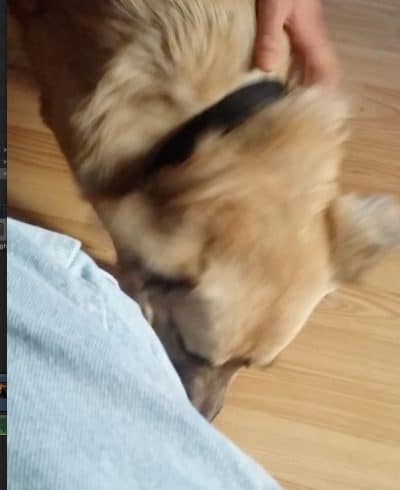
Joe: No, sit. Sit. Bear. Bear. Bear. Sit down. Good boy. Stop.
You see how he’s too interested in what’s going on over here? I just lost him. Like I’m in a classroom … hold on! Stop stop stop. I’m a teacher in a classroom and you guys are part of the class, and you’re paying attention to me like you are now, and you are looking out the window going, “Oh, I wish it was noon so I could get the hell out and go play or whatever,” right?
You’re distracted. You’re not thinking about the lesson; you’re thinking about other stuff that’s going on elsewhere, and that’s what … Hey, stop. Stop. That’s what’s going to get Bear in trouble. Sit down. Bear. Sit down. Sit down. Sit. Sit. Bear. Good, stop. Good boy. Thank you. Stop. I need him to focus on me, right? I don’t want him to be the bad example … I’m joking with you though, you understand that?
Speaker 2: Yeah.
Joe: So I want him to stay focused. I want him to stay in this process. And that’s all it is for now. This is all we’re doing is trying to get him to tune into me because I’ve never been here before. He doesn’t know who the heck I am, so I’m trying to develop a trust and a relationship with him, which is a … Sit down. Sit down. Bear, sit! Sit. Good boy. Good boy.
So he’s a little out of sorts. You can tell. He’s like, “Well, I don’t know about all this. This is really weird,” but that’s okay. Right? Right? Come here. Come here. Come here. We’re just going to do a little walking. How is he on a walk? Does he drag you? Does he-
Speaker 2: Yeah, he pulls.
Joe: He pulls? Come on. Walk walk walk. Hey, hey, hey, stop! Sit. Sit down. Sit. Good boy! Stop.
He’s just sniffing. He’s finding all kinds of ways to get engaged in other things, which is part of his issue. He doesn’t want to just stay and follow and listen and, “Hey, let’s try something new!” He’s like, “Oh, who are you? Still trying to figure you out,” sniffing, ignoring, going doing different stuff, thinking about other things. Sit down. Sit. Sit. Sit. Good boy. Stop. Stop.
So this is the first stage of getting a dog to start … No, up. Up. Sitting or laying down. Hey, come here. Good. Stop. Good boy. There you go. Now you got it. That was good. Stop!
Now I’m purposely having him face me this way. Sit down. Bear, Bear.
Speaker 2: He can get out of the …
Joe: Oh, that’s not what we want. We gotta lock it down. We gotta tighten that thing. Dogs do that and then sometimes they’ll come at me. Now that it’s off, they can get at me and I don’t like that part.
Favian: Freedom!
Joe: Yeah, that was Mel Gibson, right? Hey, what are you doing? You come over here. You come over here. You go over there.
Favian: He’s not trained yet. We’ve had him for about a month, so we’re getting there.
Joe: So is that good?
Favian: No.
Speaker 2: You made it looser [inaudible 00:19:41] Sit. Sit. Good boy.
Joe: So when you take him for a walk, it’s like this pretty much? He just drags you along.
Favian: Yeah.
Joe: Alright. And the floor is great, it’s an awesome floor, but you see when he tries to sit, he starts doing this. And so it’s hard to … We may have to go in the front. It might be nice if the neighbor’s see that you … Do they know Bear? Do they see him dragging you around the neighborhood and stuff?
Speaker 2: I don’t know.
Favian: Like I said, we hardly walk him.
Joe: Okay. There’s a lot of people, if they know a dog has been a …
Favian: They probably know that we have a very loud dog. They probably-
Joe: Okay, so that’s kind of what I’m getting at.
Favian: I know the mailman knows.
Joe: Yeah. And so when they see you working with him, then they know that you’re actually doing something to better the dog and better the neighborhood and better relationships and that kind of stuff. Good. Walk. Walk. Walk. Good. Good. Right here. Stop. No. Good boy.
See, now he’s sitting and when he stops. Which is a good thing, he’s kind of automatically sitting, and so he gets a good boy for that. So what are you doing? Again, hold on.
I’m going to tune him into me. Hey. Walk. Good boy. Yeah, very good. So he’s learning “walk,” he knows when to start walking. Walk. Hey, hey, hey. Come on, just walk. Hey! No biting! No. Sit down. Sit down. Stop. No, I don’t like that. He just nipped and now he’s turned into, “F you, I’m going to bite you,” sort of stuff. No. Stop. Stop. Hey, stop. Don’t you bite. No. Stop. Look at that dog, he’s so cute. Good. Good boy. Just walk. Good. Stop. Nice. Good. I like the wag. Stop.
Now I’m not going to make him sit. Going to change it up a little bit. I still want him to stay there, but I don’t have to make him sit every time, but that takes about 30% of his energy right off, when he drops. When he’s like, “What can I do now?” No, let’s just sit and drop some of that. Good boy. Up. No. No. Right here. Come on. Walk walk walk. There we go.
Come on. Come on. No! Bear, walk. Walk. Good. Good boy. Good boy. Good boy. Right here. Hey! Right here. Trying to keep his focus, that’s very good. That’s very good. Walk walk walk. Hey. Walk. Good. Stop. He’s very distracted. You’re seeing, right? You’re seeing how instead of staying with me and doing … was he like that at Petco, where there’s four other dogs and he’s like, “Oh, what’s that dog doing?”
Favian: At first, and then once we started training, then he was fine.
Joe: Okay, good. So you notice those sort of things, and that’s kind of what I’m keying in on. I want to also get you to start noticing, cause it’s stuff that you’ve seen, but you didn’t really maybe put it together and how it works. Overall dog-human relationship.
Favian: Right, cause how it works at the pet smart is you do the training and then you’re in the little area with all the other dogs. You do the command or whatever, then you go outside into the store in the aisles where everybody’s doing their own thing. And they have to do it there. If they don’t do it there, then you don’t get to move on.
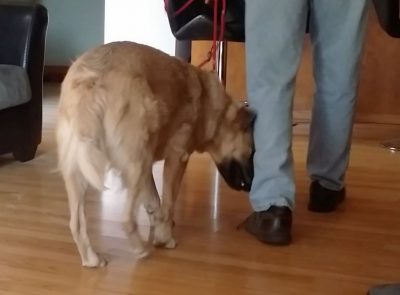
Joe: Okay, cause they’re doing the socializing part. When you’re in the store and you’re seeing people with other dogs and there’s people they gotta walk by that are looking at shelves, fat people and skinny and old ladies and whatever. That’s the socialization part, and that’s … Good boy. He’s just sitting there. He’s not moving.
He’s pointing at the direction that he was. He wants to come over here and get petted by you guys. You see? You see what I mean? Bear. Walk. Walk. Good boy. Good boy. No. This way, hey hey hey. Good boy. Walk walk walk. There. Stop. Oh! You sat too? Well, that’s perfect. That’s perfect. Good boy.
It takes a little bit of time, but he’s starting to come around. Now he’s learning stop. He’s learning come, right? He’s learning walk. I haven’t got into the techniques yet, but I’m going to mention it now cause I want you to start watching. Ah! Stop! Good boy. He sat when I said “stop,” and he sat. The moment his butt hits the ground, he gets one of these. Or whatever. A little.
He doesn’t get a “Yay!” Nothing big, but just … Good. Perfect. Again, just a little bit of treat, you can call it the loving treat instead of an edible treat, that we’re working with. And so he’s going to feel more comfortable. Good boy. And he’s looking at me, he’s watching, but he’s not watching like this. Big difference, right? He’s not … Bear! Bear! Come here. Hey, hey, hey! Stop. Stop. Sit down. Sit. No. Come here. Good boy. Sit down. Hey, good! There you go.
Now you see how he turns to face? I’m trying to get him to face me. Sit down. Sit. Come here. But he’s finding a way so that he can still face you guys. I want him perpen … there you go. Sit. Sit. Right there. Good boy. See, he’s not used to being told what to do when he’s doing his own thing. He’s used to just following through, “I want to go over here. I want to go over there. I don’t care if this leash is on, I’m doing my own thing when I want to do it,” and that’s what we’re coming over the top of.
We’re going to start redirecting all those, “I’m used to doing what I want to do when I want to do it. I don’t need no woman around me telling me what to do. I’m a single bachelor guy and I live a wild and crazy life. That’s my life,” but now, we’re going to be doing something different. We’re going to be having to listen more attentively. No, sit! Hey. Stop. Sit. Sit. Stop. Stop. Stop.
You see how he worked his way from right here to over there, so now he can still see all of you over there, right? I just want you to see that, how that works. Come here. Good. Right here. Okay, stop. Sit. Sit. Sit down. Come here, sit down. Sit. Sit. Sit down. Don’t do that. Don’t get that look in your eye. Stop. Come here.
See? Now is where he’s really starting to … sit down. Sit down. He’s really starting to rise up. He’s going, “I’m about had it up to here, dude. I’m kind of up to here now.” You know what I mean? Do you see it? I’m not making this up. I’m showing you what’s happening with the dog when he’s like, “Okay, if you pull on me again, I’m just going to bite you. I’m just tired of this crap. I want to go back to what I was doing without you, before you ever stepped into my life.” But his life is going to change now if you want him to. Okay?
So you’re going to be following through with this stuff, because that’s going to be how Bear is going to change the attitude about the doorbell. And we’re going to work on that. We’re going to get that done today too. We’re going to to definitely work with that issue, but this is part of the whole, global change of what goes on in here.
Favian: The foundation.
Joe: Yes, exactly. So you see all the flaws in his strategic design, which is, “I get to do whatever I want whenever I want to. That’s my plan.” And you’ve got other things. You’ve got people coming over. You’ve got people to protect. You don’t want to have to have this guy hold your dog back from getting at somebody. I mean, that’s not normal. That’s normal. That doggie is normal. And so we’re going to try to get you more like the other doggie, but you’re going to have to go through a little process. Yeah.
You’re going to have to go through a little process, and that’s like taking all of this and just putting it aside and just letting it go, okay? That’s what you’re going to have to do.
And most dogs end up loving me. That’s my goal, is to have them not fear me, first off, cause I don’t want them to fear me.
I want them to really respect me, but respect me in a good way. And so they can then give up the power-grab, which is a dog that will fill a void, if there’s a leader that doesn’t rise above that, and the scariness of the little fake “I’m going to bite you,” but it may not be fake. It’s like, “I’m telling you what I’m about to do. I’m about to do it,” and so I gotta keep him in line with this a little bit. No! Hey.
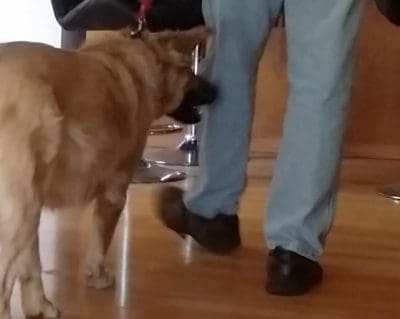
Favian: The only time he’s ever growled at us is, he turned one. Around one. And then he started to get food aggressive, and that was the only time.
Joe: With this one or before this one was around?
Favian: No, before. Way before this one.
Speaker 2: We only had him for about a month.
Joe: Sit down. No. Come here. Hey, sit. Sit. Sit. Good boy. There you go.
Favian: And that’s the only time he’s ever growled, and then we kind of checked him and then that was it.
Joe: Checked him. You mean you corrected him?
Favian: Yeah we went, and that was it.
Joe: You went what? Oh, like a poke. Okay, I’m into poke. That’s the Cesar Millan thing.
Speaker 2: Yeah, cause that’s the only thing we’ve had for … cause like I said, this is our first-time dog and whatever. And that was it.
Joe: That’s a technique that I haven’t even gotten into yet, but that we will. Because he hasn’t quite needed it. Almost, but not quite. When he’s fighting me and like, “No, I want to be here instead of here.” That’s the subtle difference of him maintaining leadership, doing what he wants to do, finding a way to get in his more than two-cents worth, and me going, “No, I’m not going to let you get away with any of that stuff.”
Because this is how you reprogram a dog that has always been the leader, let’s say, in his own mind, and so we just gotta put him back down to a mail room instead of CEO of the corporation. You’re the CEO and these are your VPs, vice presidents, right? And so they’re the ones that are going to be … you’re going to call the orders, and they’re going to be following out, they’re your commanders,
Right? So they’re going to be doing some of this stuff for you. Come on. Stop. Good.
It was just too much over there. I want him to be an open slate and ready for me to give him any command. That’s what this is all about. I mean, when he looks at me again. Good. Good boy. I want to kind of ease him up a little bit. He’s pretty tense. He’s a tense-
Speaker 2: Like I said, he’s a shelter, so we don’t know what happened to him. He’s been in a home. He hasn’t.
Joe: Well, he’s bit … No, no. Sit down. Sit. Sit. Good boy. Soon as the butt hits, boom. If you wait too long, he’s not going to connect it to what it is that we’re doing and why we’re doing it. Good. Stop. Now, watch him. He finds … Good.
And it’s also, in a sense it’s like desensitizing him from … If you’re on a computer and you’re just kind of in a nice little mellow state of mind, and then your brother comes up, “Hey man,” and you’re like, “Whoa! I didn’t see it coming,” you jump out of your skin. Your skin crawls and you’ve got one of those … that’s what happens to dogs like this. And so they slip out of … Oh! Up. Up. Up. Up. Good. Come here. Stop. Sit.
And then I want to go. I think I want to work the doorbell in right now, actually. I’m going to try to figure out how I’m going to do it.
Speaker 2: You can have one of us sit out there. Maybe you want us to ring the doorbell.
Joe: I want to have somebody ring, yeah. So …
Speaker 2: [inaudible 00:35:06]
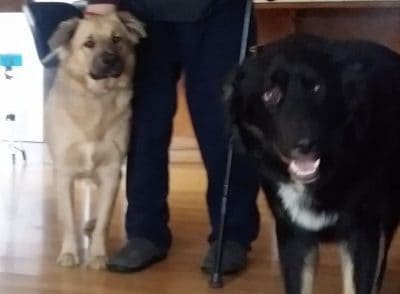
Joe: Perfect. So this is what we’re going to do, because … No! Stop. Stop. There it is. Hold on. Before you go, I want you to notice all about his energy. What happened? “I gotta deal with it. What’s going on over there? It’s my responsibility. My responsibility,” that’s what he’s saying, “to find out what he’s doing and why he’s doing it and I gotta really hyper-manage this whole situation,” and we gotta nix all that. Cause that’s going to prevent him from all that, “I’m going to kill you entering my house,” stuff. Cause you guys are going to come over the top of that as you see him progress into it, and this helps.
You cannot change a dog’s attitude. You cannot train a dog without a leash. Once they’re really trained, then you can do hand commands with them and all this stuff, but he’s not there yet. Hey. Hey. Up up up. Good. Come here. Stop. Stop. Come on.
You see, him just standing there has freaked him out. It’s changed his whole demeanor. Something’s going on. This guy’s over there, something about to happen, and I need to be involved, whatever it is. Come on. Walk walk walk.
So I’m going to get him in this circle. I want you to just go ahead and go outside and then hit that doorbell. Walk walk walk. And we’re going to see what happens. Walk walk walk. Go ahead. [doorbell 00:36:49] Stop. Stop. Stop. Stop stop stop. Stop. Stop. No, stop. Just stop. No. I don’t even like whining, cause that’s still, “Oh, I want to kill. I want to eat. I want to go. I want to do.” There we go. We’re just kind of walk him through that phase. Go ahead. Stop. Stop. Stop. That’s where the poke comes in. Stop! Sit down. Hey, sit. Stop. Stop. Stop. Stop. Shh.
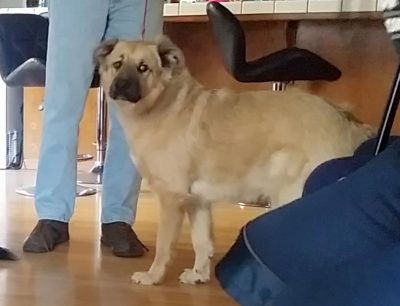
Go ahead. [doorbell 00:37:49] Stop. Stop. Stop. Stop. Stop. Stop. Stop. That’s where I’m going to get bit. Someone’s gotta get bit. Stop. Stop. That’s the scary part. Stop. Stop. Stop. Sit down. Stop. Good. Stop. Shh. Stop. Right here. Let’s have him chase [inaudible 00:38:26] Sit down. Sit down. Sit. Sit. Stop. Stop. Stop. Good. No. Come on. Right here. Sit. Stop. Okay, go ahead. Ring it again. [doorbell 00:38:50]
Hey. Stop. Stop. Stop. Stop. Stop. Stop, oh! Stop. Stop. See, he wants to bite. That’s where he comes in. Sit. Sit down. Good boy. Stop. Stop. Okay, disappear and wait about a minute outside. Close the door behind you. Wait about a minute. I don’t want you to freeze, but just … Stop. Stop.
Come on. Right here. No. Stop. Sit. Sit down. Stop. Good! Stop. Okay! [doorbell 00:40:06] Stop. No. Stop. Stop! Stop. Sit down. Stop. Good! Hold on. Hold on. There you go. No, stop! Stop. He can’t help it, he just wants to go chew or, “Ah! I gotta get all this drive and bite out of me,” you know? He wants to … No, sit down! Sit. Good boy. Stop. Stop. Stop. No. Shh.
[Stomping feet 00:40:52] See, now this doesn’t even bother him because he’s all about what’s going to happen next out there. So … Walk. Walk. Come on. There we go. Go ahead!
[doorbell 00:41:12] No, it’s okay. Stop. Sit. Sit. Stop! Good. Stop. You see when he bites at me? He will bite. You say he want to bite [inaudible 00:41:25] but that will take him out of his normal state to where, “Oh I just love everybody,” to instant reaction. It’s not a conscious thing. It’s more … No! Hey! Come on. Walk walk walk. Walk walk walk. Stop. Walk. Stop. Just walk. Is he-
Speaker 2: I can see the tail underneath him.
Joe: Oh yeah, I know. And I feel his mouth, the opening right around here. When I turn him around the corners, that’s when he starts.
Speaker 2: [inaudible 00:42:17]
Joe: Yeah. Walk walk walk. Okay! [doorbell 00:42:20] Stop. Stop. Good. Hey! Good. A lot better. Ten times better. Stop. Okay, ring it again! [doorbell 00:42:36] Stop. Stop. Stop. No. Sit. Sit. Sit. This is where sit becomes real important, cause he’s not going to listen when he’s, “Ah! I’m going to kill! I’m going to do!” Sit down. Sit. Stop. Stop. Alright, do it again! [doorbell 00:42:59] Good. Excellent. Excellent. Nice!
Speaker 2: That’s farther than we’ve got.
Joe: Huh?
Speaker 2: That’s farther than we’ve gotten.
Joe: Yeah. Well, you just didn’t really know how to … you knew he needed it, but this is why … There you go. There you go. This is why you get somebody that can help you. Okay, ring it again! [doorbell 00:43:21] Again! [doorbell multiple times 00:43:23] Good! Excellent! Sit. Good boy. Good boy.
Walk. Okay, go ahead and ring it! Keep going! Don’t bite me. Hey hey hey. When I turn these corners, his jaw comes right to my knee. Good. Keep ringing! Come on. Come on. Come on. There we go. Stop! Watch him turn and face what he wants. That’s what I mean by he will show you his hand, right? Hey, stop! Stop! He’s not going to let me turn him. Stop. Stop. Stop. Stop. Okay, that’s enough! Stop.
Holy smokey.
Speaker 2: Good workout!
Joe: It is a good workout. I was working with a dog … what’s he? Like 60? 70?
Speaker 2: 70 lbs.
Joe: I was working with a dog that was almost 100 a couple weeks ago, and that dog was twice the wanting to come at me to bite me mode.
Speaker 2: Twice as big!
Joe: And bigger. So the first half hour I ended up having a coat cause it was cold, and I went over there and I started taking stuff off cause I was just sweating trying to hold this guy. One more time! Good. Good boy. Sit. Sit down. Sit. Sit. Sit. Sit down. Sit down. Sit! Sit down. Good. Stop. Okay, again! Good. Excellent. Good boy. Good boy.
So, again, now we’re letting him know what we want. This is where it really comes in. This is where he gets the sugar in the midst of the turmoil. Good. Hey hey, stop. Ring it again! Good boy. Hey, there you go! Now he’s getting the opportunity to see my good side, the treat, the yay, not the yanking and … Thank you. This is where he’s going to get the sugar. This is what’s going to help bring him around to … what’s going on?
Speaker 2: [inaudible 00:46:00]
Joe: Getting a little needy? One more time! Good boy. Walk. Walk. Walk. Walk walk walk. One more time! Good boy. Walk walk walk. Come on. There you go. There you go. Walk walk walk. Come on. Come on. I won’t give up. Come on. Come on. Stop! Sit. Sit. Sit. Hey, sit. Bear! Sit. Stop. Alright.
So this is good stuff. So I think we’ve made some progress, right? Now you. I hope you’ve been paying attention. Have you?
Speaker 2: Yeah.
Joe: You had your thinking cap on the whole time?
Speaker 2: Yeah.
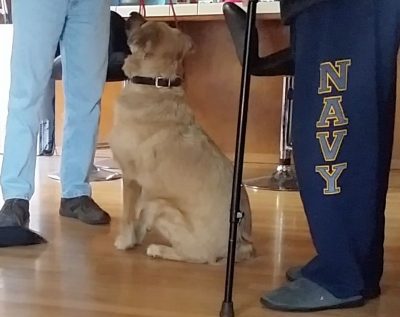
Joe: Good. Okay, so come over here. I want you to be me now. Not mean, but me. And you saw that I was firm, but I was fair. I didn’t get him to listen to me out of dominance per se, but I did not let him get away with ignoring me, so there’s a fine line. You’re not going to go extremely angry or bitter or frustrated, you’re not going to have any of those things because remember, he’s a very good energy-reader.
So if he sees that you’re afraid. Like I’ll go in a home and people are afraid of a dog like this and they don’t know how to handle them, so the dog goes, “That keeps me in control, when you’re afraid of me. When you fear me, that gives me … ” Ah, sit!
Speaker 2: Sit! Sit. Sit.
Joe: So it’s at the same time, remember. The tap and the command are at the same time. So I just want you to do a little walk in a circle here and just show me … I just want to see if we can get him to do good listening to somebody else other than me. Cause I know what I’m doing. So go ahead. Just do a little … Just say walk.
Alright, now first off, stop! Have him stop. Okay, perfect. Alright. I want you to think about your hand, your arm here, okay? Look at it. You’re in a fighting mode. Relax. Let it hang like a dead limp stump. And all your corrections are going to be right here at the wrist. They’re all going to be down here like this. Back, and when he gets too far ahead of you or when he gets too far behind you, but it’s all right here.
There’s no this. There’s no this, this, all this stuff. It’s all straight down; it’s all relaxed. You’re confident, you’re relaxed, and you’re going to say a command and mean it, but not throw it out there as a demand. It’s, “Okay, walk.” Let’s do this.
So go ahead and do some circles. Just some ovals, right in here, with him walking beside.
Speaker 2: Walk.
Joe: Good. Now you may want to get a little more distance. Pull up a little bit on the leash cause you got too much there. But what I want to make sure of is that when your arm is … straight down, relax. That you have enough limp. Right? You’ve got some … It’s not like this the whole time. He’s neither pulling you or you’re pulling him, right? It’s not that way at all. You want to try to make sure that he’s following you, and this is the test. This is to see if he’s actually with you, walking with you, or if he’s dragging you or if you’re pulling him. So give that a try.
Speaker 2: Walk. Walk.
Joe: Perfect. Cut him up. Just cut him right up. When you turn. Let’s get this dog out. Let’s get him out of the way cause we’re taking up this space. Go ahead, just start walking. You can come on in now! I forgot about you, dude.
Favian: [inaudible 00:50:25]
Speaker 2: Sit. Sit. Sit. Sit. Good.
Joe: Good, now stay with him. Back up a little bit. Don’t come in yet. Cause now he’s all about you, right? He wants to find out what you’re doing and why you’re here and who you are and how dare you? So it’s up to you, then, cause you saw how he ditched you. He just blew you off in an instant. You mean nothing to him at that point. So you want to make sure that he has your attention and that you have his attention.
So start walking and just do a nice big oval here, and I want you to walk in somewhere while you’re walking. And I want you to maybe sit here, and just be a presence. So go ahead and start walking.
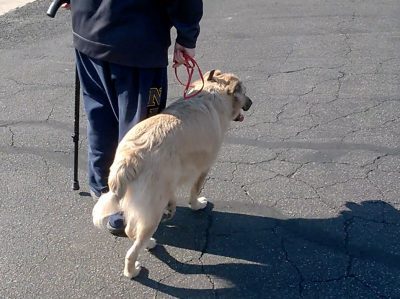
Speaker 2: Walk. Walk. Walk. Walk. Walk. Walk. There. Walk. Walk. Walk. Walk.
Joe: Once he’s walking, you don’t have to keep saying it. He’s doing what it is that the command-
Speaker 2: So what do I do when he’s distracted? And he’s looking over there [inaudible 00:52:10]
Joe: More like, “No, this is what I want.” Like over here. I want you to also learn the Cesar Millan thing was the [noise 00:52:23] He did a tsk, but I like this. It’s pharyngeal. You know what the pharyng is? It’s the part of your vocal cord that you can do the witch laugh. When you pinch together your vocal cords or whatever then it makes that sound. So that sound is a different sound than your normal vocal range that the dog is used to.
So when you do that, it cuts through. It’s like a child that hears his mother, “Jimmy do the … ” Pretty soon it becomes white noise and he just filters it out, right? Well that’s what dogs do too, so they can ignore you. So right here. Have him sit. Just sit.
Speaker 2: Sit!
Joe: But what you did was totally opposite from what I did. I did a tap with my two fingers like this, and you did a … like that. Your whole arm and body, you just yanked on him, right? So remember, just a little, that’s all he needs. He just needs to be reminded of the command.
So go ahead. And just when you’re ready, just say, “Walk,” and you tap and just start walking at the same time.
Speaker 2: Walk.
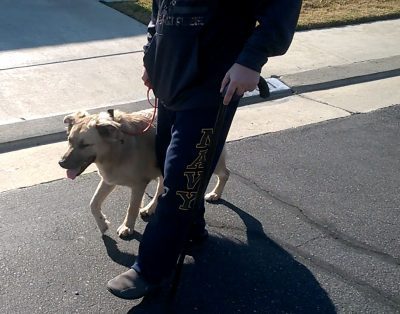
Joe: Good. And don’t even worry about him following. He will. He will just come. And I love the fact that you’re cutting him off around that corner, because what happens is … this is a great lesson right here, in itself. The dog wants to go to the right, right? He wants to go maybe where you are, and he keeps coming this way. And when you cut him off and you cut him off at that corner, now he’s gotta go, “Where did this guy come from? I’m off this direction, and next thing I know I’m getting yanked around this way.”
And so what he’s going to do, he’s going to stop focusing less and less on the other thing that he’s coming across because he’s not going to want to get a knee in his shoulder as you turn on him, right? So that’s going to force him, if you keep going. Just keep going. Just keep walking. Go a little faster. He’s spending too much time pondering, so you gotta go a little faster. Keep going.
He’s going. Go around that way, too. Take a longer route, too. Make it a little longer.
There you go. That’s too much. Right there. Now, you’re grabbing it like … all you really need is to hold it by this. That’s how I do most of the corrections, right here. I can get … Sit. Sit. Sit. Sit. Sit. Good boy.
So I don’t have to go, yank him. I’m not physically trying to put him there. I’m reminding him with, “Hello, McFly!” That’s what that is. It’s like, “Hello! I’m over here. Here we are! We’re in this room together. Let’s do this.” Alright. So when you go, you just tap and you just say, “Walk,” and you go. It’s all at the same time. And then, when you turn, just turn right on him.
Don’t worry about knocking him cause I want him to start anticipating that you’re going to walk on him and you’re going to turn on him, and so he will start turning with you instead of paying attention to something else over there. Walk walk walk. Oh, he’s getting too slow now. You want to speed him up a little bit. He’s dragging too much. Walk walk walk. Walk walk walk. Come on. Walk walk walk. Come on. There you go.
So we’re going to get in this routine right here. Walk walk walk. And now he’s hanging behind. Why? Because one, he’s getting tired. A tired dog is an obedient dog, so he’s going to become more obedient on the fact that he’s just being tired and he’s like, “Whatever. I’m just going to follow,” come on. Walk walk walk. Come on. Come on. Walk walk walk.
You’ll see that he will start tuning in and start listening to you, watching, making sure that when you start to cut him off, you don’t just have to shove him out of the way to turn him, that he’s going to, “Oh, that’s right. We’re doing this.” So that means you’re connecting with him. He’s starting to really focus on you and your walking pace and all those things about you that are gonna be different from him and are gonna be different from him. Alright, so go ahead.
Speaker 2: Walk.
Joe: Can we shut these?
Favian: The blinds? Yeah.
Joe: That’s okay. That’s alright.
Favian: I can shut them. No worries.
Joe: Nope. That’s alright.
Speaker 2: You can turn on a light.
Joe: That’s alright.
Favian: You don’t need to turn on a light [inaudible 00:57:57] those blinds.
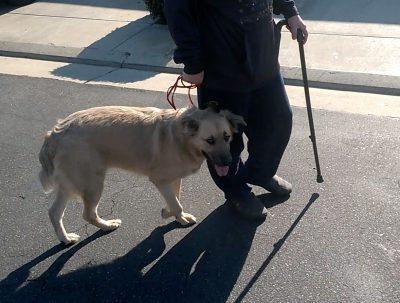
Joe: Keep going. Yeah, that’s good. So reel him in a little more, just like two inches. Just a couple inches. That’s it. Good. Cause indoors, it’s going to be a little tougher. You don’t have the range for him to kind of make wider corners like you will outside, which is where we’re going to go next. Remember your arm. Just straight down. Relax. He follows you.
Now you see he was looking around when he turned, and then his knee came across his face and he started following? So he’s going to start paying attention to that on a walk, and it’s going to be a better walk for whoever’s walking him because when he starts getting ahead of you and dragging you, then you cut him off and you change direction, you go a different direction for 10, 12 feet. And then he starts speeding up on you again, so you spin him around.
I’ll show you, but I want to kind of pre … Alright, you want to try? You’re doing really good there, by the way. I don’t know if you even notice it or not, but you’re still sleep-walking, but that’s okay.
So have him S-I-T with a tap.
Speaker 2: Sit. Sit.
Joe: Good. Now you see? Perfect. You just barely touched him, right? You didn’t have to yank him to the ground. Earlier, I did. I had to yank him to physically get him to listen to me, but now, he’s actually being a good boy. Aren’t you? He’s getting a lot of attention, which is what he wants, but he’s also getting … No, have him sit.
Speaker 2: Sit.
Joe: See, he’s doing what he wants to do and not what you want him to do. That’s going to be the difference. He saw you and goes, “Oh! [inaudible 00:59:42]” And you’re over here going, “Whoa! This dog’s out of control,” cause you gotta just start anticipating.
And I know it’s a lot of stuff. I know it, and I want you to know it, and I want you to know what I know and why I know it and when to do the techniques. And so I want to micromanage all of you guys while we’re micromanaging your dog. So it all works, right? Cool?
Okay, so hand him off. And let’s see … what’s your name?
Joel: Joel.
Joe: Joel. Oh, I’m Joe. And Joel, cool. So, have him S-I-T.
Joel: Sit. Sit. Hey.
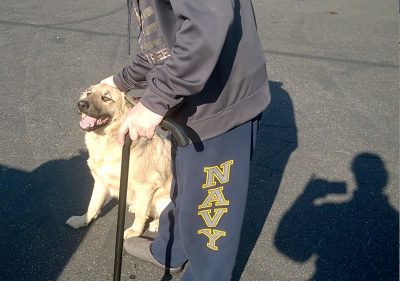
Joe: Good, now when he sits, remember: just a little thank you. Cause you want to let him know what it is that you approve of, and when he sits, you go, “Oh, good.” Not a, “Yay! He sat!” It’s just good, thank you. Just a little bit of sugar. And so when you’re ready, just go. And just start walking. Same side, we gotta walk him on the same side. That’s the left side. Everybody, we’re walking on the left. Good. It’s always good to be consistent.
Now you don’t have to grab that low. Keep going. Good. Good good good. Now, I’m going to ring the doorbell and we’re going to see what happens. But just keep going in those circles. [doorbell 01:01:17] Keep going. Like there’s no big deal. [doorbell 01:01:23] Keep going. Keep going. I’m a visitor. Right? Huh? Huh? Do I see smiles? I mean that’s good stuff.
Speaker 2: It’s more relief.
Joe: Yeah, or relief. That too, yeah. See, he’s still thinking about it. He’s still knowing that, “Oh, there should be something happening down here.” Keep going. [doorbell 01:01:57] I want you to keep him engaged when he tries to get engaged elsewhere. That’s the exercise. It’s for him to stay with you and not with what’s going on all around there. Just keep going. And the big thing is he’s not biting to get to the door, right? He’s not just, “What are you doing to me?” I got him all tired up or all bit out or something.
Joel: Hey! You gotta wait, buddy.
Joe: So relax your arm. Keep it straight. There you go. Now just remember all of the wrist, all the right down there. Keep going. But keep him walking with you. He’s all about now the little brother that showed up. So we’re making some progress. This is what I like to see. He’s not a stupid dog, he’s just a misdirected, so we’re redirecting him. And look at that walk, I mean that’s a darn good walk. That’s exactly what you want.
You want him to just be following along but not dragging you, which is where we’re going to go next. We’re going to go right out in the front, and we’re going to just start walking maybe one or two houses down and turn him around and just stay right in here, maybe walking around your property, but we’re going to just cover the areas where you mentioned first that he had those issues.
Joel: There’s a dog here up here that he’ll flip out with.
Joe: What?
Joel: There’s a dog … This house right over, that they [crosstalk 01:03:59]
Joe: Have him sit.
Joel: Bear, sit! Sit.
Joe: Wait til he sits. Good. And remember, just say “good.”
Joel: Good boy.
Joe: Just a little, just like that. Perfect. So that’s how you’re going to turn him to become a better dog, is because he’s going to start getting more of you, the good side of you, the “Oh hey! I love this dog,” you know? Puppy. Reach for the puppy. He still has puppy in him, he’s just forgotten it. He’s grown to be a big badass that maybe he doesn’t really want to be a badass. Maybe he just wants to be a submissive little puppy like this dog, just to be loved and normal and everyday, but he needs to be redirected to be that way naturally again. Maybe he was never like that or maybe he was like that.
Speaker 2: I think he started off that way.
Joe: Started off like sweet and normal?
Speaker 2: No no no. [inaudible 01:05:01] the doorbell.
Joe: Oh, okay. I’m going to try the doorbell again. Just sit. [doorbell 01:05:10]
Speaker 2: So the challenge would be without the leash?
Joe: Yeah, well we can work up to that, because you’re not going to have the leash on him 24/7. You are for the first couple months, though. I want you to leave the leash on him so that you can … when he runs by ignoring you, you can step on the leash or grab it and bring him back around and then redirect him back to whatever it is that you want him to do.
But the leash will also, it’s almost like when you sit, when the dog knows it has a leash on, it kind of takes that, “Oh damn. I’m not free again.” But it’s not a bad thing. It’s just that’s the, “Oh, it’s training session now and I gotta put on my thinking cap.” [inaudible 01:06:13] when you were sleeping earlier on the couch.
Favian: He’s always sleeping.
Joe: Do you have a sense of humor, do you? Or it takes a lot to really crack a smile on that face of yours.
Joel: I guess I’ve got a different sense of humor.
Joe: Yeah that’s okay. I mean, I like ribbing people, but they know that it’s all for good. If I didn’t like you and I ribbed you, then it would be serious, cause then you’d know I’d be giving you grief, but that’s not the case.
So, we’ve got a good dog going over here, don’t we? Don’t we? Somebody’s coming around. Somebody’s coming around. And that attitude that he’s getting into, that’s where we also want to keep him, cause you’re going to see him. You’re not going to see the, “My problem, my responsibility.” No no. You’ve just gotta go, “No, no [inaudible 01:07:12] you just lay down, no big deal. That’s my responsibility.”
Like the papers and the mortgage. Can’t have you jump up here now. I can’t explain it to you, but in a minute, now that I know what you want, and you show him your hand, show him your hand, so now that I know, but I’m not going to just acquiesce to your demands, I’m going to go, “Oh, okay. I know that he wants to get up on my lap, so hold on.” Sit down. Wait. Get my papers.
Finish the last couple of things. Gather, gather. Five minutes later, put them in a binder, close it up, and then go, “Okay!” And love him and roughhouse him and play and all that stuff that you know that he wants and that he loves. And then he gets a little rough and you go, “Okay, that’s enough,” or whatever. But it’s now you are guiding him to how you want him to.
